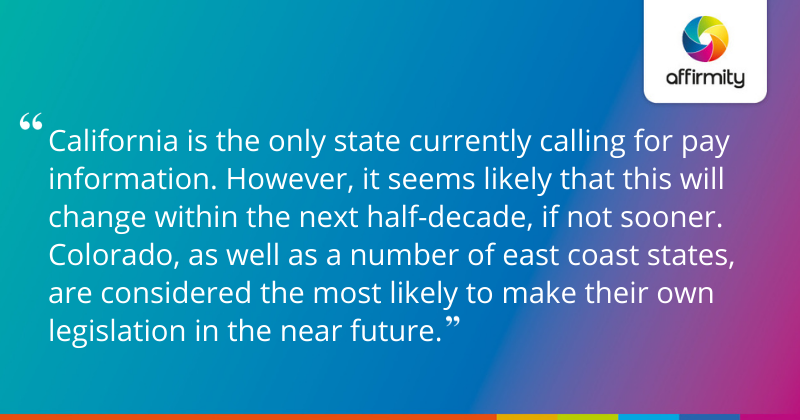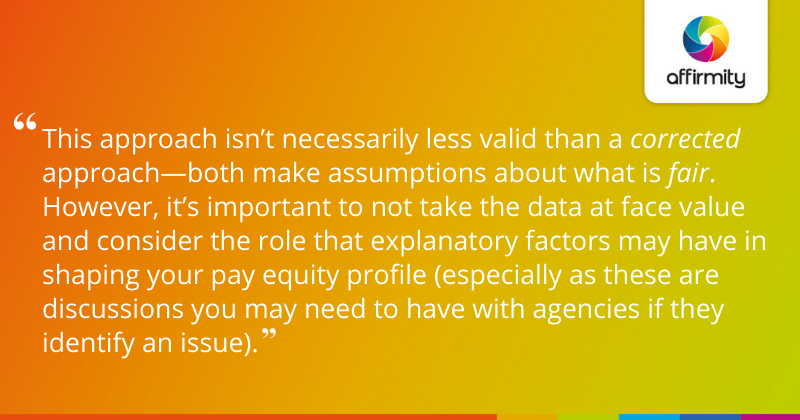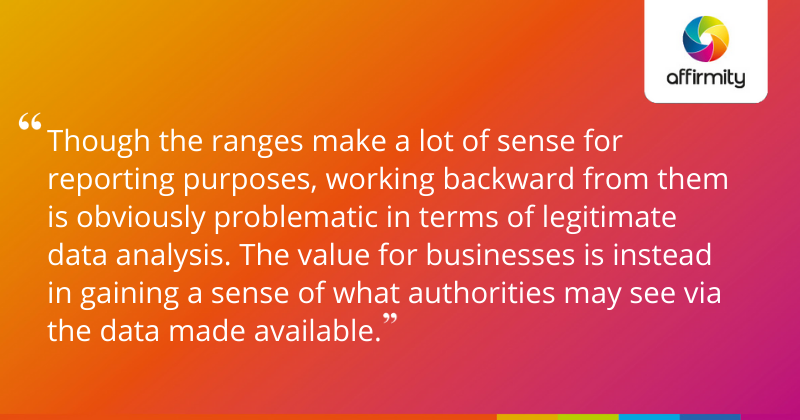An emerging trend towards per-state pay reporting requirements such as California’s SB 973 begs the question: could the data collected for these reports be used for more robust pay equity efforts? We examine the potential and the limitations of the data organizations are increasingly obliged to produce.
California’s pay reporting bill (SB 973) requires all employers with at least one employee based in or reporting to a California-based establishment to disclose their employee pay data (assuming they have at least 100 employees total).
Even if your organization doesn’t have to prepare an SB 973 report for the California Department of Fair Equity and Housing, it’s worth paying attention to, when you consider:
- Any organization with employees or establishments in California, that is also experiencing a period of growth, could find itself over the relatively low 100 employee threshold
- Any US-based organization that hires and relies on remote workers—expected to remain a popular mode of working post-pandemic—could easily find itself over the threshold with at least one employee based in the country’s most populous state
- Between bills being considered in other states and countries, and existing federal contractor-only pay reporting requirements such as EEO-1, we can expect similar requirements to apply to more and more businesses in the near future
For more information on California’s pay reporting bill, read our SB 973 guide here. Once you’re familiar with what SB 973 entails, you may be thinking about how the data it deals with can help you in the future. Or how you can better prepare your organization for the years of increased scrutiny that are likely ahead.
Where Else Do You Have Pay Reporting Data?
California is the only state currently calling for pay information. However, it seems likely that this will change within the next half-decade, if not sooner. Colorado, as well as a number of east coast states, are considered the most likely to make their own legislation in the near future.
As for existing pay reporting requirements, at a national level, there is EEO-1 Component 2. This applies only to federal contractors and differs in a few key ways from SB 973 (the most significant being that California collects data on non-binary individuals).

Multinational companies may also report pay data in other countries, including:
- United Kingdom – All companies with 250 or more employees must publicly report gender pay gap statistics.
- Germany – Companies with 500 employees or more must publish regular reports on their efforts to promote equality. Employees can also request information about the pay awarded to colleagues in a similar role (so organizations need to be set up to provide it).
MORE FROM THE BLOG | ‘Workplaces That Work: How to Create a Culture That Embraces Pay Equity’
What Are the Limitations of Pay Reporting Datasets and How Do You Overcome Them?
If you’re following the exact guidelines as set out in SB 973, EEO-1, or pay transparency reporting requirements in other markets, the data you collect does come with a few limitations.
Reports Demand a Limited Geographical Scope
The geographical scope of your reporting is likely to be a big limitation. If you’re only collecting data on employees based in or reporting to an establishment in California, you may be missing data for the rest of your organization. Similarly, you may only be collecting data about employees working in or reporting to specific countries (based on whether there is a law requiring you to do so).
Increasing the geographical scope of your data collection efforts across your entire organization will naturally give you greater insight into pay equity trends, and will get you ahead of any new reporting demands from states and countries that could be coming down the road. That said, if your reporting efforts are minimal at present, the potential time and cash investment aren’t negligible. A software reporting solution will likely be required.
Your Report Data Is Uncorrected

The pay reports you submit are, by their nature, “uncorrected”. They don’t consider any potential explanations, such as time in job or company, geographic variation, performance, potential, management, or supervision.
This approach isn’t necessarily less valid than a “corrected” approach that takes into account all of the aforementioned factors—both make assumptions about what is “fair”. However, it’s important to not take the data at face value and consider the role that explanatory factors may have in shaping your pay equity profile (especially as these are discussions you may need to have with agencies if they identify an issue).
Identifying whether any given explanatory factor provides a predictable effect on pay usually involves regression analysis—consult a statistician or Affirmity expert for more information.
MORE ON CORRECTED AND UNCORRECTED GAPS | ‘What is Fair Pay? And What’s the Difference Between Equity and Equality?’
Pay-Bands Offer Limited Insight

The SB 973 reports require the use of the pay band intervals defined by the US Bureau of Labor Statistics: Range A through L. These intervals:
- Place all employees earning $19,240 or less annually in Range A
- Place all employees earning $208,000 or more annually in Range L
- Grow considerably in scope at higher ranges:
- Range B covers salaries of $19,240 to $24,389 (so a person at the top of the same range may earn up to $5,149 more than someone at the bottom)
- Range K covers salaries of $163,800 to $207,999 (up to $44,199 difference)
Though the ranges make a lot of sense for reporting purposes, working backward from them is obviously problematic in terms of legitimate data analysis. The value for businesses is instead in gaining a sense of what authorities may see via the data made available.
One way that authorities may be working within these pay bands is to multiply the number of people in each (gender or race/ethnic) group by a figure for the top, middle, or bottom of each pay band range. This would give estimated money earned for each group to work with. This array of figures could then be divided by the number of hours worked (also provided in reporting) for an estimated hourly wage for each group. Various best-case and worst-case scenarios could then be worked out from there by comparing group wage estimates, and decisions would be made accordingly.
ALSO ON DATA | ‘Leveraging your AAP for Better Workforce Insights’
Use Cases for Repurposing Pay Reporting Data
Because of the limitations mentioned above, it’s preferable to use precise salary data if you have access to it. Nonetheless, the data that you prepare to meet your pay reporting requirements can still be useful to:
- Give a quick indication of areas in which you have pay equity issues along gender or race lines in certain roles and pay bands that deserve a more rigorous analysis
- Gain a sense of what organizations like the OFCCP or a state DFEH “see”, allowing you to proactively address issues before they’re flagged
- Separate out along establishment lines within the business as required
- Investigate areas that aren’t currently the focus of laws, such as intersections of race, ethnicity, and gender, but can nonetheless inform your DE&I initiatives and future-proofing efforts
If you’re in the process of assembling pay report data and interested in what a more comprehensive pay equity study could do for your business, contact us today.
 About the Author
About the Author
Patrick McNiel, PhD, is a principal business consultant for Affirmity. Dr. McNiel advises clients on issues related to workforce measurement and statistical analysis, diversity and inclusion, OFCCP and EEOC compliance, and pay equity. Dr. McNiel has over ten years of experience as a generalist in the field of Industrial and Organizational Psychology and has focused on employee selection and assessment for most of his career. He received his PhD in I-O Psychology from the Georgia Institute of Technology.
